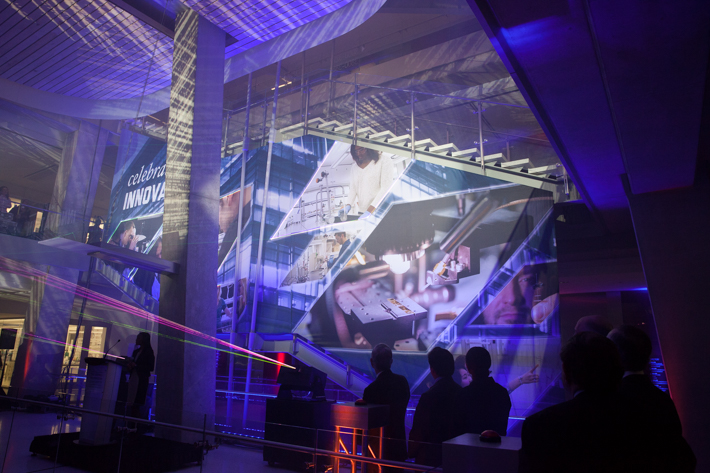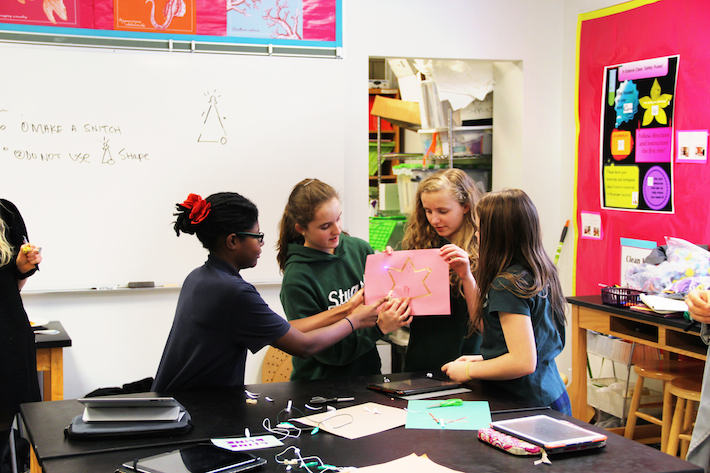By James Irwin
Seven George Washington University graduates, including the director of the NASA Goddard Space Flight Center and the chief of staff of the Applied Physics Laboratory at Johns Hopkins University, were honored Thursday night by the School of Engineering and Applied Science at the 2015 GW Engineering Hall of Fame Induction Ceremony.
Christopher Scolese, M.S. ’82, the center director at NASA Goddard, and Ronald Luman, D.Sc. ’98, a longtime member of the physics community at Johns Hopkins, were joined by Donald Blount, B.S. ’63; Gennaro Colabatistto, M.S. ’96; Elizabeth D’Andrea, D.Sc. ’06; Kevin Kelly, M.S. ’97; and Patrick Marolda, M.S. ’86, as honorees Thursday. The annual event, held at Science and Engineering Hall, featured remarks from School of Engineering and Applied Science Dean David Dolling and Provost Steven Lerman.
“This is the top of the profession—this is the best of the best in engineering and computer science at GW,” Dr. Dolling said. “In the brief time I have tonight, I can only really just touch on the depth and breadth of their accomplishments and their achievements.”
Established in 2006, the GW Engineering Hall of Fame recognizes and honors distinguished alumni, faculty, staff and friends of SEAS who have contributed to engineering, technology, management or public service in a sustained and significant way during their careers.
“This is probably the pinnacle of my career—to be recognized by my alma mater,” said Mr. Blount, who kicked off a series of short acceptance speeches.
A glance at the 2015 honorees:
- Mr. Blount is the founder of Donald L. Blount & Associates, a naval architecture and marine engineering design firm. Previously, he was a civilian employee at the Department of the Navy, where he conducted research and engineering programs relating to technology in hydrodynamics and later conducted research in the design and testing of military craft.
- Mr. Colabatistto is president of defense and security at CAE, which in 2014 was recognized by Canadian Defence Review as Canada’s No. 1 defense company. Previously, he held senior management positions at SAIC, Space Imaging, SPOT Image, and Veridian. He also served in the United States Marine Corps during Operation Desert Storm.
- Dr. D’Andrea is a senior scientist with more than 38 years in government service focused on weapons development and science and technology. She was responsible for the development of the Navy’s Railgun as well as numerous technologies focused on terrorism and drug interdiction. She has worked for NASA, the departments of the Army, Air Force and Navy, and is a three-time recipient of the Navy Superior Civilian Award.
- Mr. Kelly is CEO of LGS Innovations, a technology company with strong ties to the U.S. defense and intelligence markets. His 15-year tenure at LGS includes stints as the company’s chief operating officer and senior vice president of strategy. He previously held senior positions within General Dynamics’ Advanced Information Systems and Lockheed Martin.
- Dr. Luman, as chief of staff of the Johns Hopkins University (JHU) Applied Physics Laboratory, has provided technical leadership in undersea and missile guidance systems, ballistic missile defense and intelligence systems architectures. He has served on special assignments at the U.S. submarine force headquarters in Pearl Harbor, the Office of Naval Research, the Missile Defense Agency and the National Security Agency.
- Mr. Marolda is COO for Rolls-Royce’s Defence Division. He joined the organization in 2002 as president of Rolls-Royce Naval Marine Inc. and has since held increasingly senior roles in the marine and aerospace businesses. Mr. Marolda previously was president of Kidde Fenwal Safety Systems and earlier spent 20 years with General Electric in its Power Systems and Energy Divisions.
- Mr. Scolese became director of NASA Goddard Space Flight Center in March 2012. He previously served at NASA as associate administrator. From January 2009 until July 2009, he served as NASA’s acting administrator where he was responsible for leading the development, design and implementation of the nation’s civil space program.
A Celebration of Achievement
For the honorees, Thursday was a night of personal reflection, stretching as far back as childhood.
“I developed a passion at an early age when I had my first box of Legos,” Mr. Kelly said. “I liked to build things—I liked to create things. I went off script. When you get a little older, and you are tired of building things, you take things apart. Sometimes they go back together, many times they don’t. But you start to learn how things work.”
Others used their podium time to highlight their education at GW. Though they attended the university at different times and received different degrees, Mr. Colabatistto, Dr. Luman and Mr. Marolda each spoke fondly of their years in Foggy Bottom and how it helped them in their careers.
“That was where my professors unlocked secrets for me,” Mr. Colabatistto said. “I felt like I was learning something no one else knew, and I learned about wave propagation and analog-to-digital conversion and code theory. And I could bring that to my job every day. I was able to understand systems we take for granted every day. And that was exciting for me—to unlock those secrets of the universe.”
For Dr. D’Andrea, the tactics of a system engineer help her solve problems outside of engineering.
“I learned that at NASA,” she said. “Every complex problem you face, you decompose that problem into smaller problems you can solve. And whether you are raising your wonderful children or working through your career, it’s just a systems engineering problem. And when you look back, you are amazed at what you accomplished.”
Growing SEAS
Since its inception in 2006, SEAS has inducted 60 alumni into the GW Engineering Hall of Fame. The school has more than 22,000 living alumni, so the 60-member Hall of Fame represents a very select group.
“When I looked down at that list I, saw some of my mentors and colleagues,” Mr. Scolese said. “It’s incredible to be associated with them.”
Thursday marked the first Hall of Fame induction ceremony held inside Science and Engineering Hall, which opened last winter. The facility continues to impress—“the high bay is just to die for,” Dr. D’Andrea said—but the building, Dr. Lerman added, is nothing without the right people.
“You need facilities for people to do great things, especially in engineering—which is fundamentally much more experimental and hands-on than other fields,” he said. “You need laboratories, teaching facilities and gathering spaces that this incredible building provides. But what really makes this a great place is the faculty, staff and students who bring the activities of this building to life—the way they use the space.”





